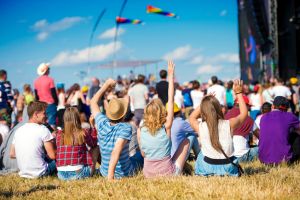[ad_1]
Summer is here and it’s the perfect time to score tickets to see your favorite bands at outdoor concerts and music festivals. A weekend at Coachella, Bonnaroo, Lollapalooza or Governors Ball can make lasting memories, but there is a downside. With sound levels upwards of 100 decibels (dB), there is a real risk of lasting hearing damage, too.
The bad news

hearing at live concerts.
According to the World Health Organization, 1.1 billion teenagers and young adults worldwide are now at risk of hearing loss due to exposure to unsafe noise levels. Loud entertainment venues such as nightclubs and concerts are a big part of the problem, and now a new study out of the Netherlands confirms it — just a few hours of exposure to loud music without hearing protection can have a detrimental effect on hearing.
Researching concert noise
The study was devised as a randomized, single blind clinical trial, to be conducted once at an outdoor music festival in Amsterdam on September 5, 2015. The goal was to determine if the use of earplugs, or the lack thereof, had an effect on temporary threshold shift (TTS). First, the study organizers put out a call for volunteers through social media. Out of 91 respondents who planned to attend the concert, 40 were excluded because they were already planning to wear earplugs to the concert. The remaining 51 were randomly assigned to one of two groups: 25 were assigned to wear earplugs to the concert and 26 were assigned to attend the concert without any hearing protection. After the 4 ½ hour concert, at which sound pressure levels averaged 100 dB, both groups received hearing tests to determine if there was a measurable TTS, and if so to what degree.
To understand TTS, it is first necessary to understand auditory threshold. Auditory threshold is the sound level below which a person’s ear is unable to detect any sound. TTS is an increase in the auditory threshold (a decrease in hearing sensitivity) which manifests itself in a temporary hearing loss during which sounds are unclear or muffled. Over time and with repeated, frequent noise exposure, ears recover more slowly from TTS. When the ears stop recovering from TTS altogether, permanent, noise-induced hearing loss is the result.
The results of the study spoke volumes. Of the group that did not wear ear protection during the concert, researchers found that 22 out of their collective 52 ears experienced a TTS at frequencies above 3000 and 4000 Hz, as opposed to only 4 out of the collective 50 ears of the group who wore hearing protection. And the rate of tinnitus (ringing in the ears) was 40 percent in the non-earplug wearing group, as opposed to only 12 percent in the group who wore earplugs.
The good news
According to the research team, led by Dr. Wilko Grolman of the University Medical Center Utrecht, results of the study are evidence that earplugs are effective in preventing temporary hearing loss as a result of excessively loud music levels, and their use should be encouraged.
When to get help
If you have attended a loud concert and sounds are muffled or you are experiencing ringing or buzzing in the ears, it is most likely only temporary. But temporary doesn’t necessarily mean there is no long-term effect. It is important to allow your ears a period of quiet rest and recovery if you are experiencing TTS. During this period of time it is crucial to avoid any loud sounds. After such a period of rest and recovery, hearing should return to normal. The recovery time for a temporary threshold shift varies, and could take anywhere from a few hours to a few days.
Be sure to seek help from a hearing care professional if your hearing does not return to normal or if you still have tinnitus after a few days.
[ad_2]
Source link

